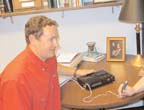Photo Files
(Click for high-res
JPG images)
introduces his students to the PMD670
PRESS RELEASE
Contact: Neilson/Clyne
Tel: (615) 662-1616
Fax: (615) 662-1636FOR IMMEDIATE RELEASE
WICHITA STATE UNIVERSITY CHOOSES
MARANTZ PROFESSIONAL PMD670— The Marantz PMD670 professional solid-state recorder provides the
portability and audio quality required for qualitative research in
Wichita State University’s Department of Communicative Disorders and Sciences —ITASCA, IL, March 4, 2005 — Clinical and research study in speech pathology are demanding applications for a recording device. Portability, low noise, extreme clarity and complete reliability are all required. It’s no surprise that Wichita State University’s Department of Communicative Disorders and Sciences found tape-based systems unsuitable. Tony DiLollo, assistant professor of speech-language pathology, says, “When you go out with a little portable tape recorder to record interviews, you get a lot of background noise and sections of the tape are difficult to understand. There’s not much you can do about it except rewind and play it again, and again, and again. People have used DAT tapes and recorders, but those are very expensive and not many people have access to them.”
Looking for a better solution, DiLollo and his department turned to the Marantz PMD670 professional solid-state recorder, which uses compact flash cards, similar to those used in digital cameras, to store audio information. A major benefit is the PMD670’s ability to interface with a computer — a single USB connection allows transfer of recordings to the computer for easy transcription and storage and archival on CD. “The PMD670 allows me to record an interview, download it to the computer and listen as I transcribe,” DiLollo explains. “I work with people who stutter, and if a section is hard to understand, it’s very easy to play it over and over.”
With 10 doctoral and 8 clinical faculty members, the PMD670’s portability is vital. Recordings of clients are made in a variety of settings, from the campus lab to homes to hospitals to nursing homes, so the PMD670 is constantly on the move.
As important as portability is audio quality. Acoustic analysis of speech allows the speech pathologists to examine problems and recommend appropriate therapies — if the recordings are good enough. “Each sound is uniquely constructed with frequencies,” DiLollo notes. “If someone isn’t sounding right, acoustic analysis allows us to identify what to work on.”
The PMD670 easily delivers the audio quality and frequency response required for accurate analysis — something competing recorders DiLollo considered couldn’t do. “The quality of the recordings is much better than anything else I’ve found on the market,” he relates. “I looked at some other digital recorders, but they just didn’t have the frequency response that was important for me. Not only that, the quality of those recordings was no better — and in some cases worse — than cassette tapes.”
The University purchased two PMD670s — one for the doctoral faculty and the other for the clinical faculty. DiLollo expects that many new applications for the units will arise beyond speech recording. “I’m sure we’ll do voice analysis, and we may like to move into using the PMD670 to demonstrate progress over time,” he says. “We do a lot of report writing for Medicare and third-party reimbursement, and this would be a very powerful way to demonstrate progress.”
Other applications have already appeared. A doctoral student used the PMD670 to record specific high-frequency components. The PMD670 delivered high-quality recordings, with very little noise, and with enough clarity to accurately reproduce the high frequencies. The future speech pathologist was able to download the recordings to a computer, and use them for tests in her work on child language and literacy.
“This student now has exposure to this research technology, and she’s seeing the clinical applications,” DiLollo says. “When students understand the technology and its applications, they can make good arguments for adopting it when they get into their own workplaces. I’m sure there are hundreds of additional applications that I haven’t even thought of yet.”
Photo File: WICHITASTATE.JPG
Photo Caption: Wichita State University professor Tony DiLollo introduces his students to the Marantz PMD670.
…ends 590 words
About Marantz Professional
A division of D&M Professional, which is also the parent company of Denon Professional and Denon DJ, Marantz Professional manufactures and distributes a reliable line of professional audio and video equipment for the broadcast, commercial, corporate, education, government, audio/visual, education, houses of worship, security, and related industries.Visit Marantz Professional at www.d-mpro.com.
About D&M Holdings Inc.
D&M Holdings Inc. (TSE II: 6735) is based in Tokyo and is the parent company of wholly owned subsidiaries Denon Ltd., Marantz Japan, Inc. and McIntosh Laboratory, Inc. Denon, Marantz and McIntosh are global industry leaders in the specialist home theater, audio/video consumer electronics and professional audio markets, with a strong and long-standing heritage of manufacturing and marketing high-performance audio and video components. A wholly owned subsidiary of D&M Holdings U.S., Inc., Digital Networks North America, Inc. (DNNA), owns the ReplayTV®, Rio® and Escient brands—all representing award-winning technologies in digital home entertainment. Additional information is available at www.dm-holdings.com.# # #
D&M Professional, 1100 Maplewood Dr. Itasca, IL 60143
Phone: (630) 741-0330 Fax: (630) 741-0652
All Rights Reserved.

